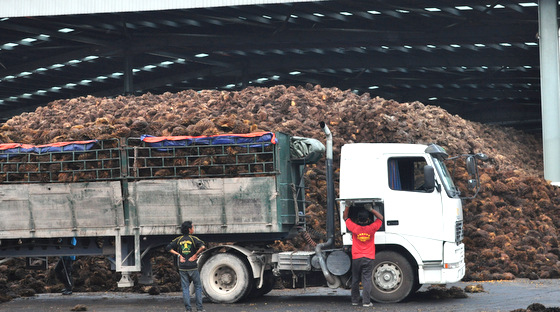 A lorry arrives at Asiatic's biomass power plant bearing empty fruit bunches (EFBs) from a nearby palm oil mill. EFPs are what is left after the mill has extracted palm oil from fresh fruit bunches (FFBs). In the background is a heap of EFBs ready to be processed to generate electricity.
A lorry arrives at Asiatic's biomass power plant bearing empty fruit bunches (EFBs) from a nearby palm oil mill. EFPs are what is left after the mill has extracted palm oil from fresh fruit bunches (FFBs). In the background is a heap of EFBs ready to be processed to generate electricity. 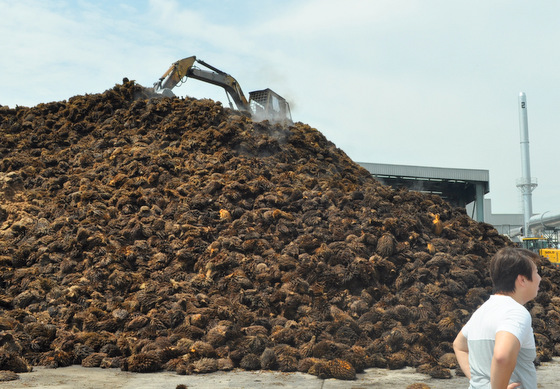 Daily, a few hundred tonnes of empty fruit bunches from nearby palm oil mills are transported to Asiatic's power plant. Palm oil mill owners are only too happy to be rid of the abundant biomass which they previously would dump in the open and leave it to rot -- or use as compost in their plantations. If left to decay in the open, the empty fruit bunches emit biogas containing methane, a greenhouse gas that causes greater harm than carbon dioxide, and is a potential fire hazard. And over time, bunches rot and excrete liquid that pollutes waterways.
Daily, a few hundred tonnes of empty fruit bunches from nearby palm oil mills are transported to Asiatic's power plant. Palm oil mill owners are only too happy to be rid of the abundant biomass which they previously would dump in the open and leave it to rot -- or use as compost in their plantations. If left to decay in the open, the empty fruit bunches emit biogas containing methane, a greenhouse gas that causes greater harm than carbon dioxide, and is a potential fire hazard. And over time, bunches rot and excrete liquid that pollutes waterways.
Photos by Leong Chan Teik
Singapore-listed Asiatic Group's joint venture has accomplished a first of sorts -- it has completed the building of the first renewable energy power plant in West Malaysia that uses empty fruit bunches (a waste product from palm oil mills) solely as its feedstock.
After four years of work, the plant in Teluk Intan, Perak, is now undergoing testing. An important milestone, successful "synchronisation" with a nearby Tenaga Nasional substation, has been reached, as announced on June 3.
Commercial operation is expected to start shortly, delivering electricity to the national grid, as we learnt during a recent visit.
Of the plant's 12.5MW capacity, 10MW will be devoted to supplying to Tenaga Nasional, with the remainder being kept for the plant's own use.
For a sense of what 1 MW represents, we learnt that in general, 1 MW can support the electrical needs of roughly 4,000 households.
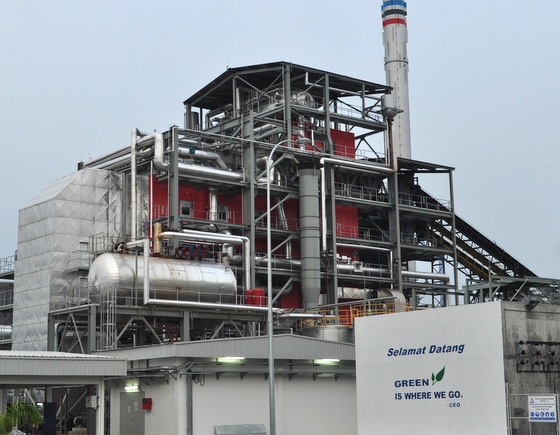 Asiatic's biomass plant cost about RM140 million. It generates electricity as well as sells residual oil that is pressed from empty fruit bunches (EFB) for making soap. In addition, the burning of the EFBs leaves behind ashes which can be sold as raw material for the making of fertilisers. The tariff payable by Tenaga Nasional to the Asiatic JV has not been disclosed but the website of the Sustainable Energy Development Authority of Malaysia states a feed-in tariff of 28.86 sen kWh for projects of the size of Asiatic's.
Asiatic's biomass plant cost about RM140 million. It generates electricity as well as sells residual oil that is pressed from empty fruit bunches (EFB) for making soap. In addition, the burning of the EFBs leaves behind ashes which can be sold as raw material for the making of fertilisers. The tariff payable by Tenaga Nasional to the Asiatic JV has not been disclosed but the website of the Sustainable Energy Development Authority of Malaysia states a feed-in tariff of 28.86 sen kWh for projects of the size of Asiatic's.
The website also states criteria for eligibility for a range of bonus rates, one of which is 9.82 sen per kWh for the use of biomass (solid waste).
The rates reflect Malaysia's policy of encouraging small renewable energy projects through financial incentives, including income tax exemption.
The tariffs enable projects like Asiatic's to achieve a high return on investment.
The plant cost about RM140 million (or S$54 million), including land cost, employs some 100 workers, and is a joint venture between Asiatic and three Malaysian partners who hold in aggregate a 70% stake. 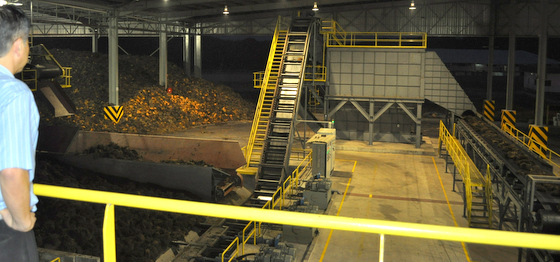 Inside the biomass plant: Empty fruit bunches (EFBs) are pressed dry and shredded before being burnt. The resultant steam drives a turbine that produces electricity.
Inside the biomass plant: Empty fruit bunches (EFBs) are pressed dry and shredded before being burnt. The resultant steam drives a turbine that produces electricity.
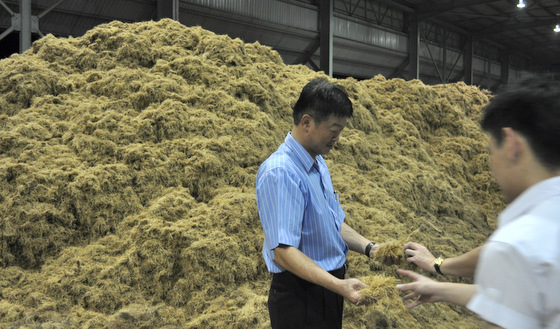 George Tan, CEO of Asiatic, shows the fibrous material resulting from empty fruit bunches being pressed and dried.
George Tan, CEO of Asiatic, shows the fibrous material resulting from empty fruit bunches being pressed and dried. 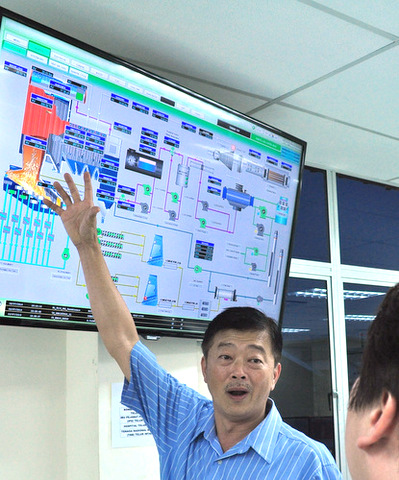 George Tan, CEO of Asiatic Group, explains the design and operation of the biomass plant in the control room.Along with two similar-sized plants using EFBs in Sabah, East Malaysia, the Asiatic plant will be a showcase for future biomass power plants in Malaysia.
George Tan, CEO of Asiatic Group, explains the design and operation of the biomass plant in the control room.Along with two similar-sized plants using EFBs in Sabah, East Malaysia, the Asiatic plant will be a showcase for future biomass power plants in Malaysia.
Maximising the commercial value of the EFBs, the Asiatic plant also derives residual palm oil from pressing empty fruit bunches, which can be sold to make soap and candles.
Water, which makes up 55% of the weight of empty fruit bunches, is collected when the bunches are squeezed and is sent to waste water treatement tanks.
It is stored for seven days for treatment by biological and chemical means to reduce pollutant loadings to safe levels before the water is discharged into waterways.
It is also in the tanks that methane, a biogas emitted during biological treatment, is collected to generate additional eletricity.
In addition, after the burning of empty fruit bunches, ash is left behind, which can be sold as raw material for fertilizers.
At Maju Intan, every bit of waste that has the potential of harming the environment is converted to commercial use.
The cost of operation and maintenance is relatively low, thus the biggest pull on profitability, accounting-wise, is the depreciation of the plant.
And, to a lesser extent, there is interest cost on the RM105 million financing for the project from Maybank Islamic Bank Berhad. 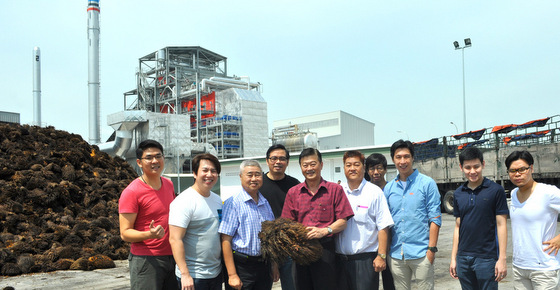 Singapore visitors with George Tan, CEO of Asiatic Group (centre, in red shirt, holding an empty fruit bunch).
Singapore visitors with George Tan, CEO of Asiatic Group (centre, in red shirt, holding an empty fruit bunch).
This is Asiatic's fifth power plant investment, further enhancing its ambition to grow its energy business on top of its core business of distributing fire-fighting and protection equipment.
Asiatic's joint ventures operate three fossil fuel power plants in Cambodia with about 30MW capacity in aggregate, and a JV is building a hydroelectric plant in Vietnam.
Phase 1 of the hydroelectric plant, which started construction in 2010 and is expected to be ready in 2016, was Asiatic's first foray into the renewable energy business.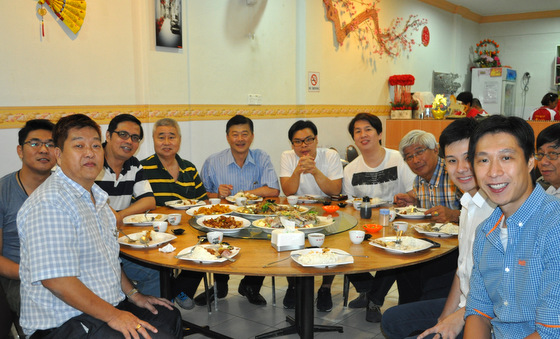 We had a most sumptuous dinner in a Teluk Intan kopi tiam with George Tan, CEO of Asiatic (centre of picture, in blue shirt), and Tan Guan Hua (in checked shirt), one of the Malaysian partners in the biomass project.
We had a most sumptuous dinner in a Teluk Intan kopi tiam with George Tan, CEO of Asiatic (centre of picture, in blue shirt), and Tan Guan Hua (in checked shirt), one of the Malaysian partners in the biomass project.
To view Asiatic's video of the workings of its biomass plant, click here.
Stock Price
AEM Holdings (AWX) 2.350 0.030 (1.29%) Best World (CGN) 2.460 0.010 (0.41%) Boustead Singapore (F9D) 0.960 0.010 (1.05%) Broadway Ind (B69) 0.128 0.001 (0.79%) China Aviation Oil (S) (G92) 0.905 -0.005 (-0.55%) China Sunsine (QES) 0.410 0.000 (0.00%) ComfortDelGro (C52) 1.490 0.010 (0.68%) Delfi Limited (P34) 0.900 0.005 (0.56%) Food Empire (F03) 1.250 -0.040 (-3.10%) Fortress Minerals (OAJ) 0.310 0.005 (1.64%) Geo Energy Res (RE4) 0.310 0.000 (0.00%) Hong Leong Finance (S41) 2.500 0.010 (0.40%) Hongkong Land (USD) (H78) 3.030 0.110 (3.77%) InnoTek (M14) 0.525 0.000 (0.00%) ISDN Holdings (I07) 0.305 0.010 (3.39%) ISOTeam (5WF) 0.043 0.001 (2.38%) IX Biopharma (42C) 0.043 0.000 (0.00%) KSH Holdings (ER0) 0.250 0.000 (0.00%) Leader Env (LS9) 0.050 0.000 (0.00%) Ley Choon (Q0X) 0.043 0.000 (0.00%) Marco Polo Marine (5LY) 0.065 -0.003 (-4.41%) Mermaid Maritime (DU4) 0.138 -0.001 (-0.72%) Nordic Group (MR7) 0.340 0.010 (3.03%) Oxley Holdings (5UX) 0.089 0.000 (0.00%) REX International (5WH) 0.136 -0.001 (-0.73%) Riverstone (AP4) 0.800 -0.005 (-0.62%) Southern Alliance Mining (QNS) 0.430 -0.020 (-4.44%) Straco Corp. (S85) 0.490 0.005 (1.03%) Sunpower Group (5GD) 0.200 -0.005 (-2.44%) The Trendlines (42T) 0.069 -0.001 (-1.43%) Totm Technologies (42F) 0.022 0.000 (0.00%) Uni-Asia Group (CHJ) 0.835 0.000 (0.00%) Wilmar Intl (F34) 3.450 0.040 (1.17%) Yangzijiang Shipbldg (BS6) 1.720 -0.030 (-1.71%)


Comments